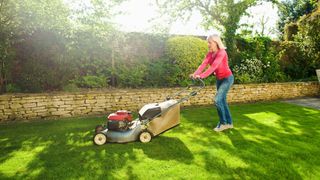In this article, we’re going to break down exactly what a self-propelled lawn mower is. While doing so, we’ll examine how long these mowers last compared to push mowers, how to mow with them, how heavy they are, and why people might use them. Self-propelling options are available for both gas mowers and the best electric lawn mowers (opens in new tab), demonstrating the widespread appeal of these devices, despite some downsides.
What are self-propelled lawn mowers?
Interestingly, self-propelled lawn mowers fulfill the same basic need as rather pricey automated lawn care devices. Unlike the best robot lawn mowers (opens in new tab), however, they are usually not extortionately expensive and still require some input on your end. Self-propelled lawn mowers normally require a bit more power than usual, due to how they move, but can often massively increase mowing efficiency and speed.
Pros and cons of self-propelled lawn mowers:
Pros:
They reduce the amount of effort for the user As such, they’re easier to move around a garden than regular push mowers Self-propelled lawn mowers can speed up the mowing process dramatically
Cons:
Due to the self-propulsion system, these mowers can be heavier than regular push mowers Often more expensive than other mowers
Self-propelled gas mowers divert some of the energy generated from the main engine into the drive system, allowing for general walk-behind speeds of 1 to 3mph. A lot of modern gas mowers use relatively powerful engines (from brands like Briggs-Stratton), and as such, this power usage does not really impact the blade speed at all. It does, obviously, use a bit more fuel, but this is fairly negligible when compared to the V-twin engine of the John Deere E180 Lawn Tractor (opens in new tab) riding mower. More powerful self-propelled mowers can get up to 4 mph, and massively speed up the mowing of your yard. So, self-propelled lawn mowers do not only make the process much easier, but inevitably speed it up a lot too. If you compare the weight of self-propelled lawn mowers against manual push models, it becomes quite obvious which type is heavier. The Craftsman M105 (opens in new tab) clocks in at 36lbs lighter than the Honda HRX217HZA, which is about the same size. Even lighter self-propelled models like the Honda HRX217VKA are 20lbs heavier than the Craftsman M105, which is itself not the lightest gas mower in the world (especially compared to 60lb mowers like the Troy-Bilt TB100). While much of this weight is offset by the power of the drive, it does make moving the mowers around the garden more difficult when they are not turned on. Generally speaking, self-propelled mowers work similarly to a car. This is not in the same way that the best riding mowers resemble a car, with full upholstery and manual gearboxes, but purely in the sense of having a transmission engine that can be front or rear-wheel drive. Rear wheel drive mowers, interestingly, tend to be more expensive than front-wheel drive self-propelled lawn mowers. This is because it’s slightly harder to configure the motor around the back of the mower (and that the back wheels tend to be bigger). Of course, the upside to this is that the drive is much more powerful, and these mowers tend to reach higher speeds. For an example of a more expensive rear-wheel drive self-propelled mower, check out our Craftsman M430 review (opens in new tab).
Do self-propelled mowers last?
Luckily, it seems like self-propelled lawn mowers do not have shorter lifespans than regular mowers. As with regular push mowers, most self-propelled models tend to last around eight years, possibly even longer if very carefully maintained. Maintenance of these mowers impacts their longevity far more than the self-propelling components in any given device. Of course, self-propelled mowers do have more parts than their regular equivalents. As such, if you’re thinking about getting a self-propelled lawn mower, learning how to change lawn mower oil (opens in new tab) is essential, to make sure that these extra parts are properly cared for. The manuals for self-propelled mowers do not mention a shorter lifespan, and neither do user reviews. Furthermore, there is not a noticeable change in the warranties included between regular and self-propelled devices, which there might be if one was more likely to break than the other. Figuring out what to do if your lawn mower won’t start (opens in new tab) can be quite difficult, but at least the reason is unlikely to be the self-propelling function.
How do you mow with a self-propelled lawn mower?
It’s incredibly easy to use a self-propelled lawn mower. Most models will have an extra catch or bar on the handle that you can press to engage the drive. With most mowers like this, the bar will control both the spinning of the blades and the drive, meaning that when you let go of it, the mower will shut down. Some higher-end mowers boast a blade override system, where releasing the bar only stops the blades from spinning. This is sometimes preferential as it means the mower can be easily pushed around the garden without the blades spinning. Self-propelled lawn mower models are very useful for hilly gardens. As has been previously mentioned, self-propelled lawn mowers do often weigh a bit more than their manual push counterparts. However, the amount of power the self-propelled drives provide far offsets this extra weight, and makes it much easier for mowing hilly lawns. In particular, they are much more useful for larger hilly gardens, as they reduce the effort of lugging such large devices up and down a sloped garden.








